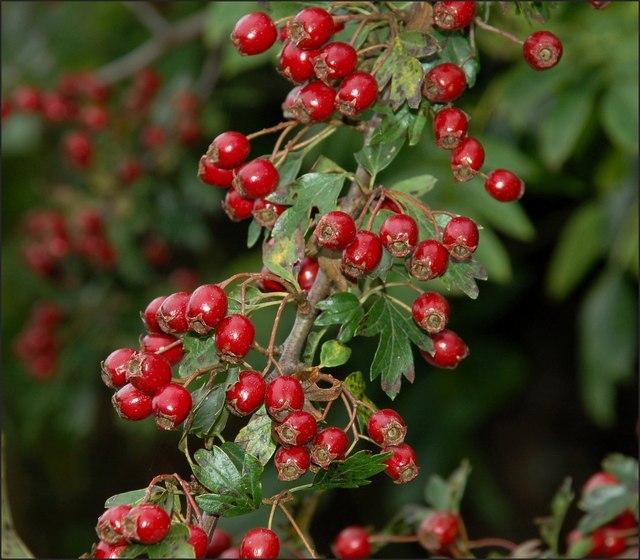Washington Hawthorn : Cultural History
While the Washington Hawthorn itself is primarily an ornamental, the Hawthorns as a group have a long tradtion of cultural signficance. From the Greeks to the Celtics, the Hawthorn is representative of many important ideas and superstittions, and even as an ornamental today remains an important tree to people all over the world. The scientific name phaenopyrum is Greek for “pear”, most likely because of the shape of the tree's outline, while the common name Washington Hawthorn is because of its original place of commercial growth, Washington D.C.
Medicinal:
Hawthorns, such as Crataegus oxyacantha, have exceptional medicinal properties, stemming from the oligomeric proanthocyanidins (OPCs) and flavanoids contained within them. The main use is for heart disease, however they have also proven useful in cases of asthma and anxiety. While many people may believe that herbal medicines are not truly useful, there has been research done to prove this mechanism is both safe and useful. This study done at the University of Michigan tested the interaction between Hawthorn tincture and other drugs used to treat heart failure, specifically Digoxin. At the end of this trial it showed that these two medicines could be coadministered safely, an important victory for herbalists everywhere. OPCs and flavanoids work by fighting free radicals and dilating the blood vessels, mainly the flavanoid proanthocyanidin. The main action of the drug is believed to be dilation of the coronary arteries that allow increased blood flow to critical regions. In addition to this, it can promote muscle growth, especially heart muscle after deterioration. The active components are contained in the leaf and flower, which can then be either made into a liquid extract or ground into capsules. All of these effects together make for an important herbal treatment for heart disease, which affects hundreds of thousands of people yearly in the U.S.
Consumption:
There are few applications for modern human consumption of Hawthorn products, including jellies, but in the past they were much more widely used. Many Native Americans used local varieties of Hawthorns to make a primitive form of coffee from the berries, as well as smoking the leaves as an alternative to tobacco. To them, the Hawthorns were an important addition to a mostly wild-foraged diet, and these traditional recipes remain an important part of their hertiage. However,in modern times animals are the main consumers of the fruits of these trees. A study showed that the Cedar Waxwing, a bird native to the Northern United States, relies of the Washington Hawthorn for almost all of its dietary needs.
Religious Icons:
The Washington Hawthorn is not particularly significant here, but another type of Hawthorn is renowned by those of the Christian faith, most likely one of the species native to England. It is also a Christian Symbol of the struggles against paganism, as it is said that the thorn of Christ was made of Hawthorn, but represents magic in the pagan world as well, so there is a struggle between these two groups.
The Hawthorn is also a common theme in Celtic mythology as the tree inhabited by the "Wee Folk", or fairies. The Hawthorns were seen as the gateway to the fairy world, a “hinge” that used its thorns to act as a guardian. The blossoms can also be used in garlands, a typical use in May festivals because this is the peak of their flowering season.
Other lore associated with the Hawthorn comes from the Druids, who warned against coming inside carrying a sprig of Hawthorn, as it brings bad luck for a year. To the Celtics it is a tree of balance and duality, between the beautiful blossoms and dangerous thorns. It is also known as the May Tree, symbolic of purification and sacred union and the original May Poles were also made of Hawthorn. The Holy Thorn planted by Saint Joseph of Arimathea is believed to be a Hawthorn, and there is ritual celebration of this every December (Bowman, 2006).
Many other cultures have rituals using the Hawthorn, such as the Greek and Romans. The Greek would construct crowns using Hawthorn blossoms for marrying couples, while the Romans would place branches in baby’s cribs for protection.



